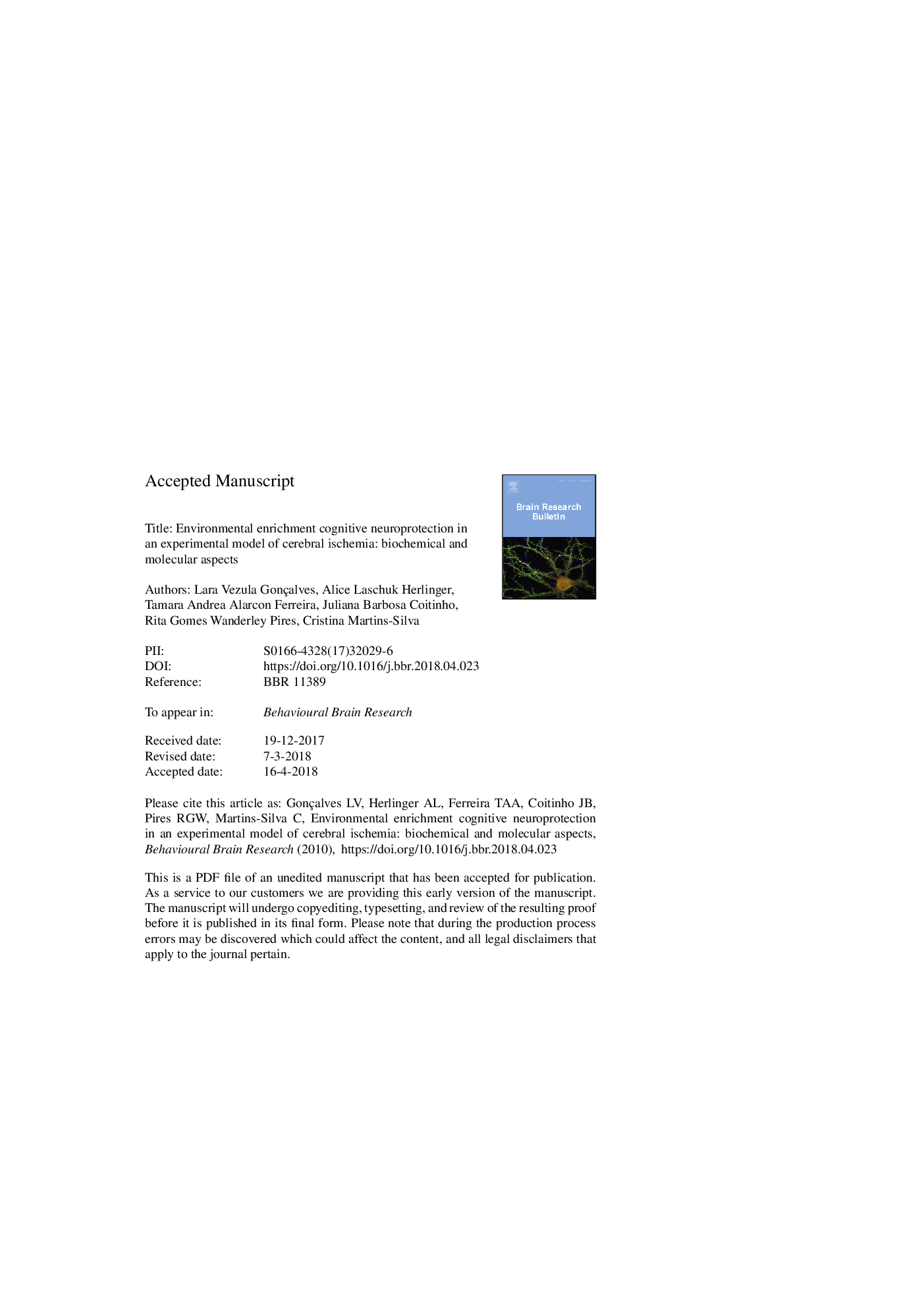| کد مقاله | کد نشریه | سال انتشار | مقاله انگلیسی | نسخه تمام متن |
|---|---|---|---|---|
| 8837750 | 1612887 | 2018 | 47 صفحه PDF | دانلود رایگان |
عنوان انگلیسی مقاله ISI
Environmental enrichment cognitive neuroprotection in an experimental model of cerebral ischemia: biochemical and molecular aspects
ترجمه فارسی عنوان
حفاظت از نوروپاتولوژی غنی سازی محیطی در یک مدل آزمایشی ایسکمی مغزی: جنبه های بیوشیمیایی و مولکولی
دانلود مقاله + سفارش ترجمه
دانلود مقاله ISI انگلیسی
رایگان برای ایرانیان
کلمات کلیدی
PI3KTNFcommon carotidCaMKIVNORBCCAoNMDARN-methyl-d-aspartateNMDALTMSTMCREBERKGFAPα7 - A7BDNF - BDNF یا فاکتور نورونزایی مشتقشده از مغز IL-1 β - IL-1βrt-PA - RT-PACerebral ischemia - ایسکمی مغزیinterleukin 1 beta - اینترلوکین 1 بتاlong-term memory - حافظه بلندمدتshort-term memory - حافظه کوتاه مدتbilateral common carotid artery occlusion - دو طرفه انسداد شریان کاروتید مشترکEnvironmental enrichment - غنی سازی محیط زیستBrain-derived neurotrophic factor - فاکتور نوروتروفی مشتق شده از مغزtumor necrosis factor - فاکتور نکروز تومورphosphoinositide 3-kinase - فسفینوزیتید 3-کینازRecombinant tissue plasminogen activator - فعال کننده پلاسمینوژن بافت بازمیگرددNeuroprotection - محافظت نورونی یا محافظت از عصبEnriched environment - محیط غنی شدهNovel Object Recognition task - وظیفه شناسایی شیء رمانcAMP response element binding protein - پروتئین اتصال دهنده عنصر پاسخ cAMPGlial fibrillary acidic protein - پروتئین اسیدی فیبریلاسیون گلایالExtracellular signal–regulated kinases - کینازهای تنظیم شده سیگنال خارج سلولیN-Methyl-d-aspartate receptors - گیرنده های N-methyl-d-aspartateLearning and memory - یادگیری و حافظه
موضوعات مرتبط
علوم زیستی و بیوفناوری
علم عصب شناسی
علوم اعصاب رفتاری
چکیده انگلیسی
Stroke is considered a major cause of global morbidity. Currently, there are no effective treatments for post-stroke cognitive impairment. Enriched environment (EE) has been brought forward as a preconditioning method to induce cerebral tolerance in an ischemic event. However, the subjacent mechanisms involved in this tolerance are not yet clear. Herein we aimed to identify the mechanisms of neuroprotection triggered by EE preconditioning in a murine model of ischemic stroke. In order to do so, C57Bl/6 mice were kept for five weeks either in EE or in standard environment (SC) prior to ischemic injury through bilateral carotid occlusion (BCCAo) or sham surgery. To evaluate cognitive deficits resulting from ischemia, animals were subjected to a set of behavioral test to assess short-term (STM), long-term (LTM) and working memory (WM) performance. Despite no effect of EE having been observed in LTM and WM, EE preconditioning was able to prevent short-term deficits in response to ischemia. This improvement was accompanied by a reduction in the infarct volume in animals following EE pre-exposure. Next, we aimed to analyze the expression of genes involved in cholinergic (M1 and alpha 7 receptors) and glutamatergic (NMDA subunits GluN1, GluN2A, GluN2B and GluN2C) neurotransmission, inflammatory mediators (GFAP and IL-1β) and of the neurotrophin BDNF. Animals tested for STM did not present alterations in the expression of glutamatergic or cholinergic receptors; however, EE was shown to prevent increased expression of IL1-β. On the other hand, in animals submitted to LTM task, EE exposure lead to increased GFAP expression in EE animals that underwent ischemic injury, affecting also the expression of NMDA subunits. In spite of that, no alterations in glutamate content were observed in either group. Altogether, this study suggests that the changes observed in the expression of glutamatergic receptors, the reduction of the inflammatory cytokine IL1-β expression and the increased expression of GFAP in ischemic animals might contribute to the cognitive improvement induced by the EE paradigm.
ناشر
Database: Elsevier - ScienceDirect (ساینس دایرکت)
Journal: Behavioural Brain Research - Volume 348, 1 August 2018, Pages 171-183
Journal: Behavioural Brain Research - Volume 348, 1 August 2018, Pages 171-183
نویسندگان
Lara Vezula Gonçalves, Alice Laschuk Herlinger, Tamara Andrea Alarcon Ferreira, Juliana Barbosa Coitinho, Rita Gomes Wanderley Pires, Cristina Martins-Silva,
